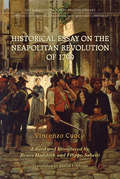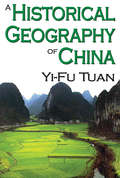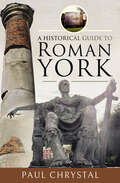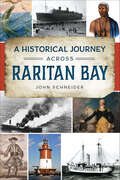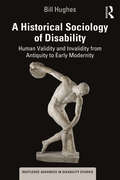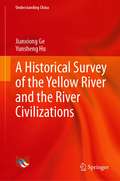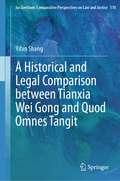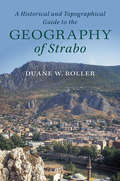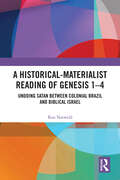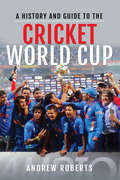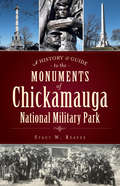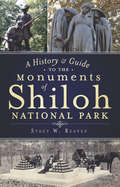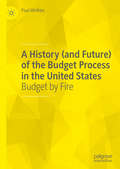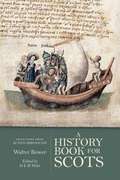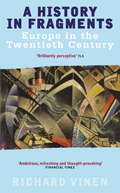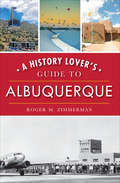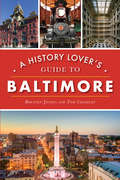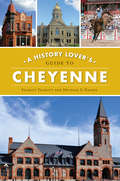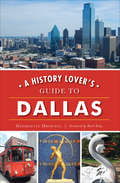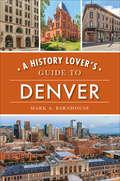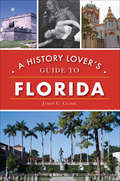- Table View
- List View
A Historical Essay on the Neapolitan Revolution of 1799
by Bruce Haddock David Gibbons Vincenzo Cuoco Filippo SabettiDeeply influenced by Enlightenment writers from Naples and France, Vincenzo Cuoco (1770-1823) was forced into exile for his involvement in the failed Neapolitan revolution of 1799. Living in Milan, he wrote what became one of the nineteenth century's most important treatises on political revolution.In his Historical Essay on the Neapolitan Revolution of 1799, Cuoco synthesized the work of Machiavelli, Vico, and Enlightenment philosophers to offer an explanation for why and how revolutions succeed or fail. A major influence on political thought during the unification of Italy, the Historical Essay was also an inspiration to twentieth-century thinkers such as Benedetto Croce and Antonio Gramsci.This critical edition, featuring an authoritative translation, introduction, and annotations, finally makes Cuoco's work fully accessible to an English-speaking audience.
A Historical Geography of China
by Yi-Fu TuanThe Chinese earth is pervasively humanized through long occupation. Signs of man's presence vary from the obvious to the extremely subtle. The building of roads, bridges, dams, and factories, and the consolidation of farm holdings alter the Chinese landscape and these alterations seem all the more conspicuous because they introduce features that are not distinctively Chinese. In contrast, traditional forms and architectural relics escape our attention because they are so identified with the Chinese scene that they appear to be almost outgrowths of nature. Describing the natural order of human beings in the context of the Chinese earth and civilization, "A Historical Geography of China" narrates the evolution of the Chinese landscape from prehistoric times to the present.Tuan views landscape as a visible expression of man's efforts to gain a living and achieve a measure of stability in the constant flux of nature. The book ranges the period of time from Peking man to the epoch of Mao Tse-tung. It moves through the ancient and modern dynasties, the warlords and conquests, earthquakes, devastating floods, climatic reversals, and staggering civil wars to the impact of Western civilization and industrialization. The emphasis throughout is on the effect of a changing environment on succeeding cultures.This classic study attempts to analyze and describe traditional Chinese settlement patterns and architecture. The result is a clear and succinct examination of the development of the Chinese landscape over thousands of years. It describes the ways the Communist regime worked to alter the face of the nation. This work will quickly prove to be crucial reading for all who are interested in this pivotal nation. It goes far beyond the usual political spectrum, into the physical and social roots of Chinese history.
A Historical Guide to Roman York
by Paul ChrystalConsidering that York was always an important Roman city there are few books available that are devoted specifically to the Roman occupation, even though it lasted for over 300 years and played a significant role in the politics and military activity of Roman Britain and the Roman Empire throughout that period. The few books that there are tend to describe the Roman era and its events in date by date order with little attention paid either to why things happened as they did or to the consequences of these actions and developments. This book is different in that it gives context to what happened here in the light of developments in Roman Britain generally and in the wider Roman Empire; the author digs below the surface and gets behind the scenes to shed light on the political, social and military history of Roman York (Eboracum), explaining, for example, why Julius Caesar invaded, what indeed was really behind the Claudian invasion, why was York developed as a military fortress, why as one of Roman Britain’s capitals? Why did the emperors Hadrian and Severus visit the fortress? You will also discover how and why Constantine accepted and projected Christianity from here, York’s role in the endless coups and revolts besetting the province, the headless gladiators and wonderful mosaics discovered here and why the Romans finally left York and Roman Britain to its own defence. These intriguing historical events are brought to life by reference to the latest local archaeological and epigraphical evidence, to current research and to evolving theories relating to the city’s Roman treasures, of which can be seen in the Yorkshire Museum in York, or in situ.
A Historical Journey
by John SchneiderThe historic Raritan Bay stretches from Staten Island to Sandy Hook, including the beach communities of Monmouth County. With its proximity to New York City and Jersey shore attractions, the bay region has been the setting for compelling moments throughout American history. The native Lenapes harvested oysters and fished the waters along the bayshore generations before Dutch and English colonists reached their coasts. Local slave Titus Cornelius, or Colonel Tye, escaped from bondage and led Loyalist forces in raids to destabilize the area during the Revolutionary War. Steamships traversed the bay carrying hordes of vacationers from New York to newly established resorts along the "Riviera of New Jersey" in the early twentieth century. Climb aboard as author John Schneider takes readers on a historical journey across Raritan Bay.
A Historical Sociology of Disability: Human Validity and Invalidity from Antiquity to Early Modernity (Routledge Advances in Disability Studies)
by Bill HughesCovering the period from Antiquity to Early Modernity, A Historical Sociology of Disability argues that disabled people have been treated in Western society as good to mistreat and – with the rise of Christianity – good to be good to. It examines the place and role of disabled people in the moral economy of the successive cultures that have constituted ‘Western civilisation’. This book is the story of disability as it is imagined and re-imagined through the cultural lens of ableism. It is a story of invalidation; of the material habituations of culture and moral sentiment that paint pictures of disability as ‘what not to be’. The author examines the forces of moral regulation that fall violently in behind the dehumanising, ontological fait accompli of disability invalidation, and explores the ways in which the normate community conceived of, narrated and acted in relation to disability. A Historical Sociology of Disability will be of interest to all scholars, students and activists working in the field of Disability Studies, as well as sociology, education, philosophy, theology and history. It will appeal to anyone who is interested in the past, present and future of the ‘last civil rights movement’.
A Historical Survey of the Yellow River and the River Civilizations (Understanding China)
by Jianxiong Ge Yunsheng HuThis book explores the relationship between rivers and ethics in China, with a particular focus on the health of the Yellow River and China’s sustainable development. Though the book falls into the category of East Asian History, it is an interdisciplinary academic work that addresses not only history, but also culture, human geography and physical geography.It traces the changes in the Yellow River over time and examines the origin and developmental course of Chinese civilization, which has always been closely intertwined with the Yellow River. It also draws comparisons between the Yellow River and the Yangtze, Nile, Tigris, Euphrates and Indus rivers to provide insights into how they have contributed to civilizations. At the same time, it discusses the lessons learned from people’s taming the Yellow River.Most significantly, the book explores the relationship between humans and the environment from an ethical standpoint, making it an urgent reminder of the crucial role that human activities play in environmental issues concerning the Yellow River so as to achieve a sustainable development for China’s “mother river.” The intended audience includes academic readers researching East Asian and Chinese history & culture, geography, human geography, historical geography, the environment, river civilizations, etc., as well as history and geography lovers and members of the general public who are interested in the Yellow River and the civilization that has evolved around it.
A Historical and Legal Comparison between Tianxia Wei Gong and Quod Omnes Tangit (Ius Gentium: Comparative Perspectives on Law and Justice #110)
by Yifan ShangThis book explores the historical and legal importance of two principles, Quod Omnes Tangit, and Tianxia Wei Gong, which have played significant roles in European and Chinese political and legal history. While Quod Omnes Tangit has been thoroughly researched, Tianxia Wei Gong has not been systematically examined. This thesis fills this void and connects these two principles for the first time. Quod Omnes Tangit was initially introduced in Justinian's Codex Civil, while Tianxia Wei Gong originated from Liji, one of the books in a key series of works by Confucius. Liji is comparable to the Thora in the Old Testament and is considered as important as law in Chinese legal history. Both principles have undergone comparable developmental processes, with scholars contributing to their reinterpretation. This book thoroughly examines the interpretations of individual scholars, with particular attention given to Liang Qichao, who is the only one to have mentioned both Tianxia Wei Gong and Quod Omnes Tangit. The book also provides an explanation for the original discrepancies in their concepts, particularly their methodologies in distributing and legitimizing rights. This research will be of interest to legal philosophers and historians in both the Western and Eastern worlds, legal practitioners and policymakers, and researchers seeking to explain current events and explore fundamental differences between the East and West.
A Historical and Topographical Guide to the Geography of Strabo
by Duane W. RollerStrabo's Geography, completed in the early first century AD, is the primary source for the history of Greek geography. This Guide provides the first English analysis of and commentary on this long and difficult text, and serves as a companion to the author's The Geography of Strabo, the first English translation of the work in many years. It thoroughly analyzes each of the seventeen books and provides perhaps the most thorough bibliography as yet created for Strabo's work. Careful attention is paid to the historical and cultural data, the thousands of toponyms, and the many lost historical sources that are preserved only in the Geography. This volume guides readers through the challenges and complexities of the text, allowing an enhanced understanding of the numerous topics that Strabo covers, from the travels of Alexander and the history of the Mediterranean to science, religion, and cult.
A Historical-Materialist Reading of Genesis 1-4: Undoing Satan between Colonial Brazil and Biblical Israel
by Ron NaiweldThis book offers a historical-materialist reading of the opening chapters of the book of Genesis in an attempt to revive their potential to engage people in truthful discussions about power and pleasure.For the past two millennia, biblical stories have been told and discussed in countless settings; whether one lives in Europe or in a country that was colonized by Europeans, the biblical symbolic universe remains present. This book offers a method to explore the social and political meanings of its most theological content by visiting two historical settings in which biblical modes of expression intersected with the demands of an economic-political process: Jerusalem and its province during the Persian period (5th–4th centuries bce) and Brazil of the early colonial period (16th century ce). Though distant in time and space, both were moments of comparable transformation: individuals with financial resources and military power arrived from the East to seize control over lands and means of production, subjugating the population to a distant king. By turning to these two historical settings, Ron Naiweld examines how the narratives of Genesis resonated in these environments, how they were used to legitimize imperial power structures, and how they opened these structures to scrutiny. The volume is part of a larger trend of reading the Bible with a historical-materialist approach that allows us to grasp the power of its symbolic universe to inspire both utopia and barbarism, especially in colonial contexts.This book is suitable for students and scholars interested in the biblical symbolic universe and Jewish and Christian history. It is also of interest to those working on the history of Brazil, comparative literature, and the intersection of religion, economy, and politics.
A Historiography of the Modern Social Sciences
by Roger E. Backhouse Philippe FontaineA Historiography of the Modern Social Sciences includes essays on the ways in which the histories of psychology, anthropology, sociology, economics, history and political science have been written since the Second World War. Bringing together chapters written by the leading historians of each discipline, the book establishes significant parallels and contrasts and makes the case for a comparative interdisciplinary historiography. This comparative approach helps explain historiographical developments on the basis of factors specific to individual disciplines and the social, political, and intellectual developments that go beyond individual disciplines. All historians, including historians of the different social sciences, encounter literatures with which they are not familiar. This book will provide a broader understanding of the different ways in which the history of the social sciences, and by extension intellectual history, is written.
A History & Guide to the Cricket World Cup
by Andrew RobertsA corker cricket book for longtime fans and rookies alike—a history of each of the eleven World Cup tournaments, including in-depth statistics. The Cricket World Cup is one of the most watched global sporting events and its celebrated history consumes fans around the world. Now, each of the eleven tournaments has been written up to include records of matches and individual performances, as well as a brief setting of the scene. Clear and concise, these chapters include the relevant statistics (highest and lowest totals, match aggregates, highest partnerships, top individual batting and bowling performances and biggest and smallest victory margins, etc.). Quirky findings such as the lowest team total to include a century partnership, birthday performances, most batsmen bowled out in an innings, as well as many more, are revealed in the miscellany section, and are sure to delight cricket lovers. A History & Guide to the Cricket World Cup is informative, factual and engaging, making it the perfect companion for fans.
A History & Guide to the Monuments of Chickamauga National Military Park (Landmarks)
by Stacy W. ReavesThe Battle of Chickamauga was the most significant Union defeat in the western theater of the Civil War and the second-deadliest battle of the war behind only Gettysburg. Chickamauga and Chattanooga National Military Park was established in 1890, the first of America's national military parks. Immediately after the battle, both Union and Confederate soldiers sought to honor those who gave their lives, and now Chickamauga and Chattanooga are home to more than seven hundred monuments, markers and tablets commemorating those who sacrificed. And much like the soldiers who bravely fought, each monument has its own history. Join Stacy W. Reaves and photographer Jane D. Beal as they recount the history of Chickamauga Battlefield and the monuments that memorialize its history.
A History & Guide to the Monuments of Shiloh National Park (History & Guide)
by Stacy W. ReavesThe events of the Battle of Shiloh are characterized by acts of bravery, sacrifice, and uncommon valor. After the Civil War, northerners and southerners alike were compelled by another sense of duty at Shiloh the duty of remembrance. Established just over three decades after the battle ended, Shiloh National Park gave veteran groups from states across the country an opportunity to memorialize their regiment's specific contributions. Each monument, like the soldiers themselves, has a story to tell. A History and Guide to the Monuments of Shiloh National Park recounts the history of the park's creation and the monuments' construction. Join former Shiloh National Park interpreter and seasonal guide Stacy W. Reeves as she charts the paths through the park's grounds and traces its fascinating history.
A History (and Future) of the Budget Process in the United States: Budget by Fire
by Paul WinfreeThe United States has one of the most unique budgeting processes of any modern government. The “powers of the purse” are enumerated under the Constitution, but they were hotly debated by the nation’s founding fathers. However, the lack of a legal guide for exactly how to delegate the powers, and under what conditions, has led to a process marked by power struggles—primarily between Congress and the presidency—over the last 230 years. Still, the budget and appropriations process is central to the functioning of the federal government. This book covers the transformation of American government through the lens of shifting budgeting power, while documenting the evolution of economic policy through the federal budget. As the nation and the federal government have expanded, the budget process has entirely broken down. This book also recommends changes that would help the budget process function more effectively. The chapters are organized both chronologically and topically to help the reader think through the evolution of the budget process. With its comprehensive approach to the history of the budget process—covering the entirety of US federal existence—this book will be a go-to resource for academics and public policy professionals interested in Congressional and executive history.
A History Book for Scots: Selections from the Scotichronicon
by Walter BowerRiveting selections from a 15-century account of Scottish history, one of Scotland&’s national treasures. Writing on a small island in the Firth of Forth in the 1440s, Walter Bower set out to tell the whole story of the Scottish nation in a single huge book, the Scotichronicon— &“a history book for Scots.&” It begins with the mythical voyage of Scota, the Pharaoh&’s daughter, from Egypt with the Stone of Destiny. The land that her sons discovered in the Western Ocean was named after her: Scotland. It then describes the turbulent events that followed, among them the wars of the Scots and the Picts (begun by a quarrel over a dog); the poisoning of King Fergus by his wife; Macbeth&’s usurpation and uneasy reign; the good deeds of Margaret, queen and saint; Bruce&’s murder of the Red Comyn; the founding of Scotland&’s first university at St. Andrews; the &“Burnt Candlemas;&” and the endless troubles between Scotland and England. Weaving in and out of the events of Bower&’s factual history are other subjects that fascinated him: harrowing visions of hell and purgatory, extraordinary miracles; the exploits of knights and beggars, merchants and monks; the ravages of flood and fire; the terrors of the plague; and the answers to such puzzling questions as what makes a good king, and why Englishmen have tails. This monumental work, in which the original Latin text appears side by side with a translation in modern English, was completed in 1998. It includes an introduction and notes that guide the reader through the complexities of Bower&’s history and its background.
A History In Fragments: Europe in the Twentieth Century
by Richard VinenThe problem with the history of twentieth-century Europe is that everyone thinks they know it. The great stories of the century - the two world wars, the rise and fall of Nazism and communism, female emancipation - seem self-evidently important. But behind the grand narratives, the politics and the ideologies, lies another history: the history of forces that shaped the lives of individual Europeans.That is the thrust of Richard Vinen's magisterial survey of this uniquely destructive and creative century. It argues that there is no single history that encompasses the experience of all Europeans, but rather a multiplicity of different, partially interlocking, histories. Some of these histories are told here in a book which seeks to root the generalisations of large-scale analysis in the concrete - and sometimes incongruous - details of individual lives. Challenging, informing and revealing, this is history writing at its finest.
A History In Fragments: Europe in the Twentieth Century
by Richard VinenThe problem with the history of twentieth-century Europe is that everyone thinks they know it. The great stories of the century - the two world wars, the rise and fall of Nazism and communism, female emancipation - seem self-evidently important. But behind the grand narratives, the politics and the ideologies, lies another history: the history of forces that shaped the lives of individual Europeans.That is the thrust of Richard Vinen's magisterial survey of this uniquely destructive and creative century. It argues that there is no single history that encompasses the experience of all Europeans, but rather a multiplicity of different, partially interlocking, histories. Some of these histories are told here in a book which seeks to root the generalisations of large-scale analysis in the concrete - and sometimes incongruous - details of individual lives. Challenging, informing and revealing, this is history writing at its finest.
A History Lover's Guide to Albuquerque
by Roger M. ZimmermanA landmark-by-landmark tour of New Mexico&’s largest city, with photos and facts on its fascinating past. This tour of Albuquerque, New Mexico, goes beyond the traditional guidebook to offer a historical journal detailing an area rich with diverse cultures and dramatic events. The journey through time starts with the settlement of Native Americans in pueblos along the Rio Grande and then initiatives by Spain to settle and convert the region. Visit Old Town Plaza, where trade from the El Camino Real and Santa Fe Trails flourished. Look around lesser-known sites, including railroad depot facilities, major military landmarks and nostalgic Route 66. Join local history expert Roger Zimmerman as he carefully curates an expedition through each era of Albuquerque&’s history and its most beloved sites
A History Lover's Guide to Baltimore (History & Guide)
by Brennen Jensen Tom ChalkleyNeither southern nor northern, Baltimore has charted its own course through the American experience. The spires of the nation's first cathedral rose into its sky, and the first blood of the Civil War fell on its streets. Here, enslaved Frederick Douglass toiled before fleeing to freedom and Billie Holiday learned to sing. Baltimore's clippers plied the seven seas, while its pioneering railroads opened the prairie West. The city that birthed "The Star-Spangled Banner" also gave us Babe Ruth and the bottle cap. This guide navigates nearly three hundred years of colorful history--from Johns Hopkins's earnest philanthropy to the raucous camp of John Waters and from modest row houses to the marbled mansions of the Gilded Age. Let local authors Brennen Jensen and Tom Chalkley introduce you to Mencken's "ancient and solid" city.
A History Lover's Guide to Bar Harbor (History & Guide)
by Brian ArmstrongBar Harbor has evolved from humble beginnings to become one of Maine's most popular destinations. This tour goes beyond the typical travel guide to explore its fascinating historical sites in detail. A trail of existing buildings and monuments provides a backdrop for an unconventional history of places, people and events, with many previously unpublished photographs and untold entertaining stories. Discover the changes wrought by the world wars, the Spanish influenza, Prohibition and the Fire of 1947. Tour the Way Bak Ball, La Rochelle, the Casino and the Wharf. From Bar Harbor's first African American sea captain to the story of the two Miss Shannons, author Brian Armstrong offers a fascinating look into the history behind some of Bar Harbor's most famous landmarks.
A History Lover's Guide to Cheyenne (History & Guide)
by Starley Talbott Michael E. KasselCelebrating at their encampment near Crow Creek on July 4, 1867, railroad surveyors named the settlement after the local Cheyenne tribe. By the time the Union Pacific Railroad arrived in November, the town had grown from a tent city to a "Hell on Wheels" town of ten thousand souls. Cattle barons brought herds to graze the open range, while they reposed in mansions on Millionaires Row. By 1890, the gleaming dome of the new capitol building was visible all the way down Capitol Avenue to the majestic Union Pacific Railroad Depot. Authors Starley Talbott and Michael Kassel explore a rich past, including the origins of the F.E. Warren Air Force Base, the foundation of the world's largest outdoor rodeo and the unheralded history of early aviation that eclipsed Denver.
A History Lover's Guide to Dallas (History And Guide Ser.)
by Georgette DriscollFrom the 19th century to today, a guide through the historic Dallas, Texas, and its culture, parks, and sports. Don't let the drawl fool you—Dallas boasts a dynamic history full of explosive growth. The cityscape itself seems eager to measure up to the outsized personalities that forged the town's identity. A sixty-seven-and-a-half-foot-tall giraffe statue greets visitors to the Dallas Zoo, while guests exiting the Joule Hotel encounter the gaze of a thirty-foot eyeball. A colossal Pegasus glows above it all from its perch on top of the Magnolia Petroleum building. Subtler storylines also thread their way through the forest of glass and steel, from the jazz of Deep Ellum alleyways to the peaceful paths of the Katy Trail. Author Georgette Driscoll looks beyond the inscriptions for the events that shaped Dallas into the city it is today.
A History Lover's Guide to Denver (History & Guide)
by Mark A. BarnhouseColorado’s Mile High City sits atop a mountain of Old West history—from stories of fortune seekers to captains of industry, immigrants to activist women. Founded in an unlikely spot where dry prairies meet formidable mountains, Denver overcame its doubtful beginning to become the largest and most important city within a thousand miles. This tour of the Queen City of the Plains goes beyond travel guidebooks to explore its fascinating historical sites in detail. Tour the grand Victorian home where the unsinkable Molly Brown lived prior to her Titanic voyage. Visit the Brown Palace Hotel suite that President Dwight and First Lady Mamie Eisenhower used as the “Summer White House.” Pay respects at the mountaintop grave of the greatest showman of the nineteenth century, Colonel William F. “Buffalo Bill” Cody. From the jazzy Rossonian lounge where Ella scatted and Basie swung to gleaming twenty-first-century art museums, author Mark A. Barnhouse traces the Mile High City’s story through its historical legacy.
A History Lover's Guide to Detroit (History And Guide Ser.)
by Karin RiskoA traveler&’s guide through the history and historic sites of the Motor City. The auto heritage of Detroit, Michigan, is known worldwide, but this fascinating city&’s history runs much deeper. Step inside the tiny recording studio where Berry Gordy, a young entrepreneur who faced tremendous prejudice, created a music empire that broke down racial barriers. Tour Art Deco masterpieces so spectacular they're called &“cathedrals&” to commerce and finance. Walk in the footsteps of Dr. Martin Luther King Jr. to Cobo Hall, where he first delivered his &“I Have a Dream&” speech. Join Karin Risko for an intimate tour of the city that put the world on wheels and discover an amazing history of innovation, philanthropy, social justice and culture.
A History Lover's Guide to Florida (History & Guide)
by James C. ClarkExplorers and pirates, hurricanes and shipwrecks, movie stars and presidents—a journey through Florida’s history and a guide to the places it happened.More than any other state (except Nevada), Florida is a state of transplants—where a quarter of the population comes from outside the US, and a third comes from other states. Thanks to its famous beaches and tourist attractions, it’s often thought of as more a destination than a home…even for those who live there. In spite of this—or perhaps because of it—the Sunshine State has one of the richest histories in the nation. Decades before the Pilgrims, the Spanish celebrated Thanksgiving in Florida. Centuries before the first St. Patrick’s Day Parade in New York, the holiday was celebrated in St. Augustine, where urban renewal was underway when Jamestown settlers arrived. In this lively guide, James Clark offers a lifetime of places to explore and facts to fascinate, tracing the state’s long and colorful history from Pensacola to the Florida Keys. You’ll find photos, illustrations, and detailed lists of 10 forts, 10 wars, 5 flags that flew over Florida, 40 historic landmarks, 50 museums, and much more.
